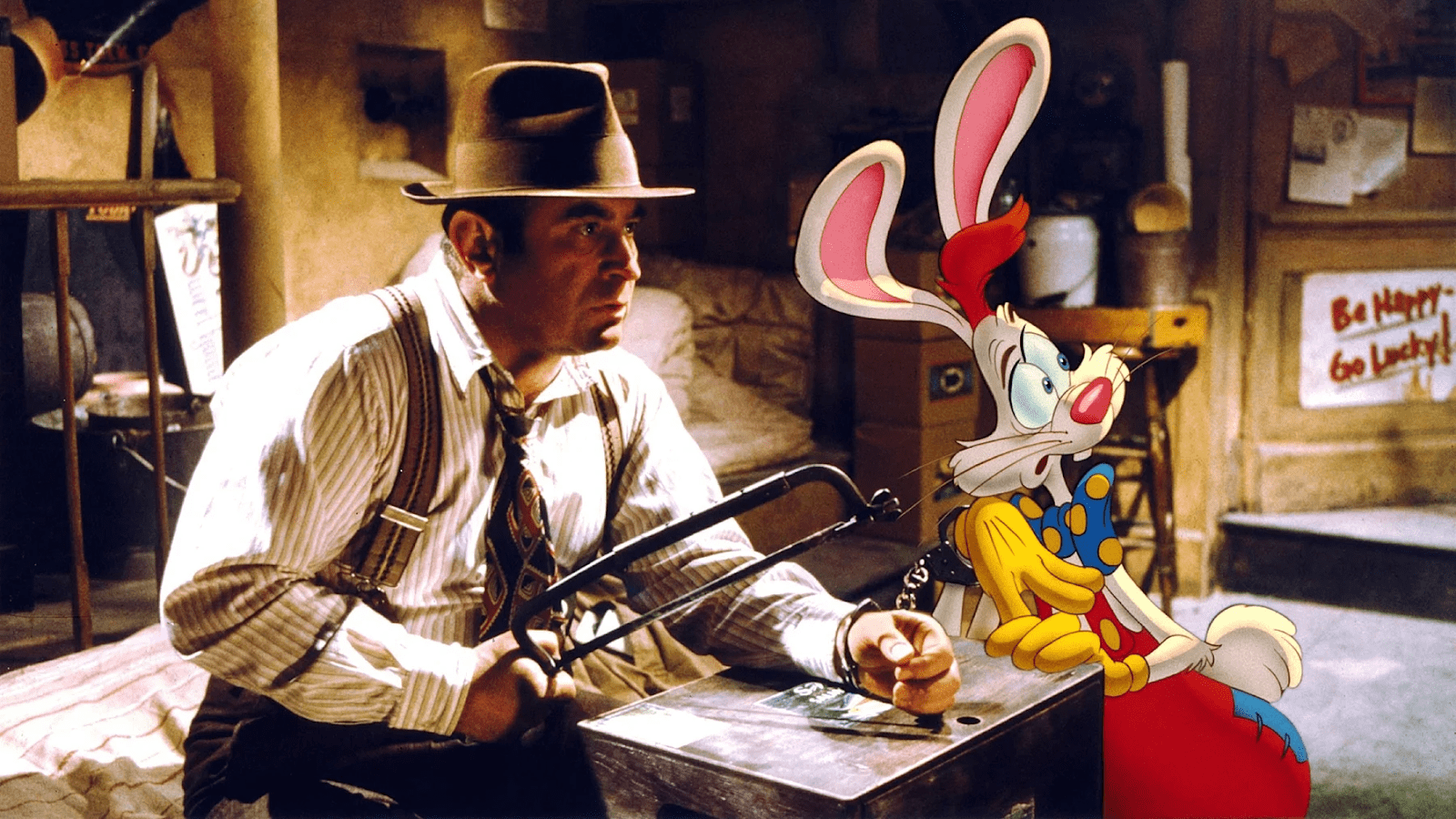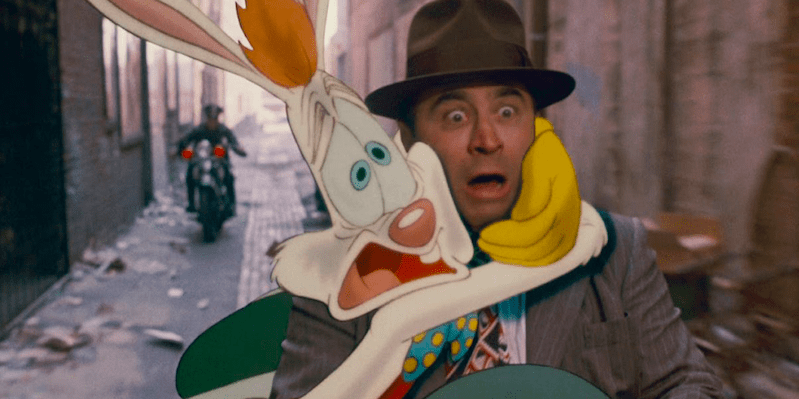(A version of this article was shared with Pirates and Princesses on April 1, 2023.)
Can you believe Disney/Touchstone’s Who Framed Roger Rabbit is creeping up on its 35th anniversary. The zany, lovable, and groundbreaking film pushed the boundaries of animation and hybrid filmmaking further than ever before. Add in dozens of characters from across the animation spectrum, “just a dash” of character copyright protections, and Marvin Acme’s missing will, and we celebrate one of the most complicated films ever produced. There are many, many fascinating trivia tidbits about this epic tale, which could fill up a small novel. But let’s select a few of the best fun facts about this “looney” Disney film.
Who Designed Roger Rabbit?

Animator Richard Williams was hired to direct all animation for the film, and he was also directly involved in the creation of Roger himself. Williams wanted to evoke the look and feel of the entire animation world around the time of the film’s 1947 setting. As such, he sought inspiration from the animation greats of the time, including the Disney Studios, Warner Bros., and legendary animator Tex Avery.
Williams boiled Roger’s design down to a “Warner’s face”, a “Disney body”, and a “Tex Avery attitude.” Roger’s face proudly represents the Looney Tunes vibe with his fuzzy Bugs Bunny cheeks, and the tuft of orange hair atop his head is reminiscent of Droopy Dog.
Roger’s wardrobe consists of a single outfit (as well all know – classic cartoon characters almost always wear the same clothes all the time). His baggy overalls evoke a sense of Goofy. His yellow, four-fingered gloves fall in line with many cartoon character hands of the day, including Mickey Mouse, Bugs Bunny, Goofy, and plenty others. Roger’s trademark blue and yellow polka dot bowtie pays a strong homage to Porky Pig.
When you look at Roger’s character coloring as a whole, what do you see? Red overalls, white fur, and a primarily blue bowtie. Williams based Roger’s color scheme on the American flag so “everyone would subliminally like it.” Whether Williams intended or not, this patriotic color palette is very much a nod to Walt Disney. Walt was a true blue American to the core, once proudly stating “Actually, if you could see close in my eyes, the American flag is waving in both of them and up my spine is growing this red, white and blue stripe.”
For his inspired work on Roger, as well as his supervision of this immensely complex collection of characters, Williams received a Special Achievement Award at the 1989 Academy Award ceremony.
Animation Overload

While Who Framed Roger Rabbit is first and foremost a Disney film, it famously features iconic characters from around the animated universe. Aside from Roger (since he is functionally a shared property), Disney featured over 80 distinct characters, most notably Mickey, Minnie, Donald, Daisy, Goofy, Pluto, Tinkerbell, and most of the cast of Snow White and the Seven Dwarfs, Dumbo, Bambi, among other Disney films of the era. In addition, Disney included 14 “groups” of more general characters, such as the weasels who have appeared in The Wind in the Willows and Mickey’s Christmas Carol, the walking brooms from Fantasia, and the dancing fauna from the 1932 Silly Symphony short Flowers and Trees.
Outside of Disney, Warner Bros. contributed 19 characters, including Bugs Bunny, Daffy Duck, Elmer Fudd, Porky Pig, Tweety Bird, Sylvester, Road Runner, and Wile E. Coyote, among others.
Other characters popping into the film include MGM’s Droopy Dog, Paramount’s Betty Boop, Universal’s Woody Woodpecker, and RKO’s Felix the Cat, to name just a few.
So who didn’t we see in Toontown? A combination of legal copyright issues and time constraints kept many characters off the screen, including Popeye the Sailor, Chip and Dale, Pepe Le Pew, Mighty Mouse, Tom and Jerry, Casper the Friendly Ghost, Witch Hazel, Heckle and Jeckle, and even Superman.
Judge Doom

The sour, creepy, hate-filled Judge Doom is a complex villain. For most of the film, he appears to just be an evil man bent on erasing Toontown (and all of its Toon residents) from existence. As we later come to learn, the judge is a Toon himself, thereby increasing the horror of his planned scheme, now being directed against his own community.
Christopher Lloyd – whose humorous acting roles run the gamut from a dopey dim-witted blue-collar worker (Taxi) to a brilliant, if wacky, scientist (Back to the Future) – played the judge with a subliminal, unsettling menace. Aside from his obviously ominous midnight black clothing and threatening cane, there is another, somewhat subconscious, reason for the judge’s creepiness – he never blinks. This component of Doom’s character appearance was included in the character’s description by film director Robert Zemeckis. It’s a subtle feature, but one that adds that extra uneasiness to someone who is already quite scary looking. Christopher Lloyd was sharp, and figured out that Judge Doom was a Toon when he read the introduction of his character in the script, and it was stated that the judge never blinks. Nice work, doc!
A Historical Hybrid

Who Framed Roger Rabbit certainly isn’t the only animated/live action hybrid film Disney ever created. It follows a line of classics such as Song of the South, Mary Poppins, and Bedknobs and Broomsticks, among others. In fact, Walt Disney himself, along with Disney Legend Ub Iwerks, created a series of hybrid short films in the 1920s known as The Alice Comedies.
But what makes Roger Rabbit unique is that it is the only film released under the Touchstone Pictures label to be an animated/live-action hybrid. While on the subject of Touchstone Pictures – this film and Tim Burton’s The Nightmare Before Christmas (1993) are the only films under the Touchstone label that are considered official Disney films.
Another note of distinction – Roger Rabbit is the first hybrid film under the Disney umbrella to be rated PG by the Motion Picture Association of America (MPAA).
Bump the Lamp

Most Disney fans are familiar with Walt’s philosophy of “plussing” things – where you take something that’s already great and make it just a little bit better. A more modern, Disney film-based term for going that extra mile was coined during the production of Who Framed Roger Rabbit.
Partly through the film, there’s a scene where detective (and begrudging protagonist) Eddie Valiant takes Roger into the back room of a bar, to cut off a pair of handcuffs. During this scene, Eddie bumps into a hanging lamp, which swings back and forth for the duration of the scene, casting constantly moving shadows. Animators of the scene had to perform an excruciating amount of effort to match up the real shadows in the room with the animated shadows on (and from) Roger. You can watch the scene here.
This extra effort was insisted upon by animation director Richard Williams to make the scene just a little bit more memorable. The effort earned the term “Bumping the Lamp” by Disney employees.
Bonus Trivia: What’s the Password?

Near the beginning of the film, Eddie’s investigation into Roger’s behavior takes him to the “Ink & Paint Club” to check out the doings of Roger’s wife Jessica. Like most prohibition-era nightclubs, the entrance was staffed by a tough-looking guard (in this case an animated gorilla). When the guard asks Eddie for the password to enter, Eddie correctly responds “Walt sent me”. This was the ultimate nod to Walt Disney – a true Hollywood legend.
There you have it – five(ish) fun facts from the wacky world of Toontown. Follow Roger through a rabbit hole out of Toontown to visit some other Disney bunnies in Disney Rabbits – An “Earresistible” Group. Are you a fan of Who Framed Roger Rabbit? Let me know with a direct message on social: Instagram Facebook X




